Fire Extinguisher Toolbox Talk – [Quick & Easy for 2023]
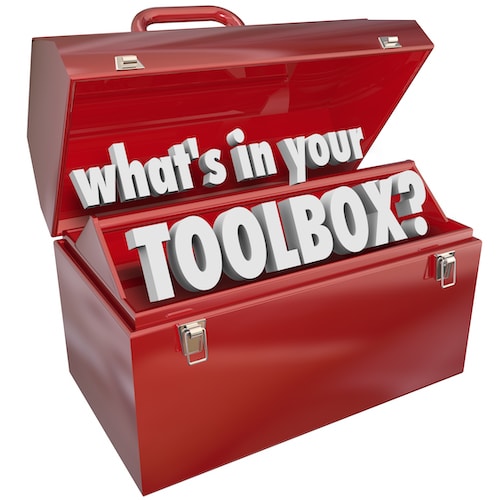
If you keep fire extinguishers in your workplace, you must train workers on how and when to use them. Along with proper training on how to use a fire extinguisher, the best way to achieve this is with a fire extinguisher toolbox talk. We’ve got a quick and easy one for you here!
Our guide covers what to include in a talk, how to ensure your training achieves its purpose, and everything employees need to know about responding to a fire emergency.
How Do You Use a Fire Extinguisher Toolbox Talk?
A toolbox talk is a brief meeting between management and employees. It takes staff through basic procedures to follow in a hazardous situation. It will generally cover topics such as identifying the classes and types of fires, when to use a fire extinguisher, and what else to do in an emergency (e.g. contact the local fire department).
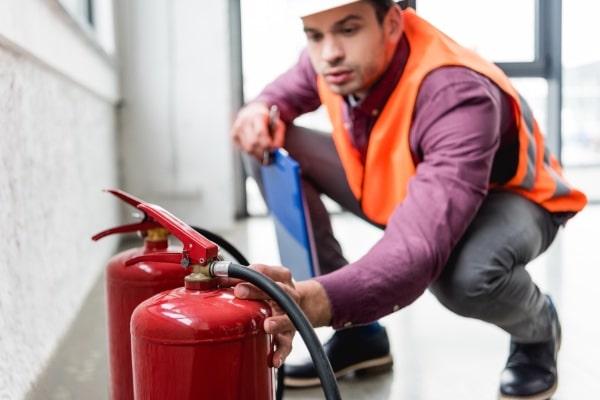
Different Types of Fires
The first topic covered will be the class system for fires. There are four different classes – each class has unique causes and calls for an appropriate response. Here’s how to identify different types of fires.
- Class A. A class A blaze is caused by combustible material igniting. Examples of these materials include paper, cardboard, wood, and plastic. These might have combusted in a small trash can or on someone’s desk due to a rogue spark. Class A blazes can generally be tackled safely using the closest fire extinguisher or by throwing water on them.
- Class B. These blazes are caused by grease or flammable liquids. They can’t be tackled using water – you’ll need an extinguishing agent like foam or carbon dioxide (CO2) to extinguish Class B fires. Typically, Class B fires occur in locations like kitchens, garages, supermarkets, or industrial plants.
- Class C. This is an electrical blaze. There are two types of live electrical fires – those confined to the electrical area and those that catch onto class A materials. Carbon dioxide can be used to treat the former type of class C fires; a dry chemical fire extinguisher is also appropriate. If class A materials have caught significantly, then only a dry chemical agent should be used, as the CO2 won’t be able to displace oxygen fast enough to prevent the class A materials from burning. Note that if class A materials are burning due to electrical fires, you shouldn’t use water on the class A materials.
- Class D. This is a rare type of blaze involving combustible metals and is most commonly found in industrial plants. Class D fires should be treated using metal powder extinguishers. These contain special extinguishing agents that prevent the metal from coming into contact with oxygen – class D fires are caused by volatile metals like magnesium or sodium.
Toolbox talks should always cover these classes because using the wrong fire extinguishers can have disastrous consequences. For example, if you throw water on fires involving flammable liquids, you’ll witness a massive flare-up of flames, potentially worsening the problem. You’ll also release vast amounts of smoke that can cause choking.
Picking the right fire extinguisher for the job is important, whether in the office, warehouse, or home.
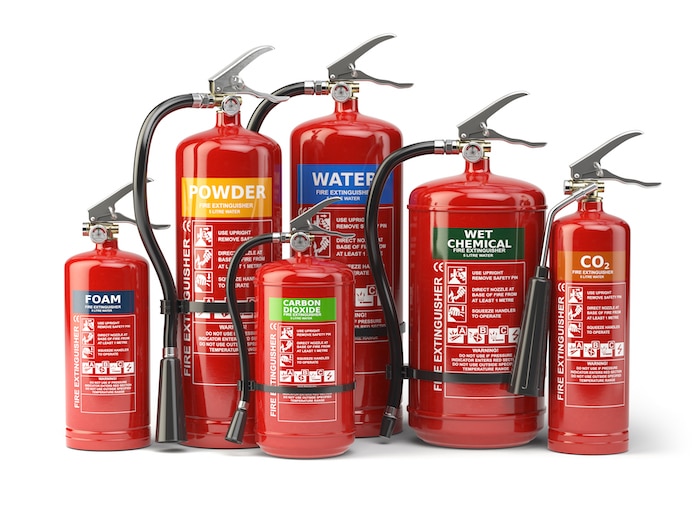
Different Extinguishers
Employees need to know how to differentiate between the various models. There are four categories in the U.S.
- Type A. These contain pressurized water. They’re only used to tackle combustible materials like wood, cardboard, and plastic. They can only be used on class A blazes – using them on other types could lead to flare-ups, electrical shock, or even explosions if used on class D blazes.
- Type K. These are commonly found in kitchens and other areas where grease or oil is present. Type K contains pressurized foam, which is effective at smothering greasy blazes.
- Type BC. These contain pressurized carbon dioxide. Type BC units can be used to tackle electrical blazes as long as they haven’t spread to nearby combustible materials. They’re also used to put out pan fires in kitchens, although type K is more common for this purpose. This model may not be effective on an electrical blaze if it has spread to nearby materials as the pressurized CO2 can only displace the heat from a small area.
- Type ABC. This is a dry chemical extinguisher and arguably the most useful model to have in your workplace. This is because it can tackle all classes, even class D. Discretion should be used if a type A blaze is active – it might be wiser to treat it using a type A where possible, as type ABC models tend to be more expensive to replace.
In general, workplaces that keep type A and type BC extinguishers on the premises are prepared for most eventualities. A type ABC model is an excellent investment as it can be used for all kinds of blaze but comes with a higher price tag. It’s also important to understand the expiration date of your fire extinguisher so you can be sure they are always ready to go in an emergency situation.
When to Use a Fire Extinguisher
Any employee trained to extinguish a fire must perform an on-the-spot assessment when a fire breaks out.
- How big is the blaze? If the flames are out of control and widespread, fire extinguishers won’t be of much use. The most important thing is to get to safety.
- Where is the nearest fire extinguisher? If you can’t safely get to any appropriate fire extinguishers, don’t try.
- Do you have the right extinguisher? It is essential to know which extinguishers you have on the premises and where they’re kept. If you can only reach a foam-based extinguisher, but it’s a class C fire, you can’t tackle the blaze.
If it’s only a small fire and you have the appropriate unit to extinguish the blaze, you’re ready to tackle the flames as long as you’re trained in fire extinguisher safety.
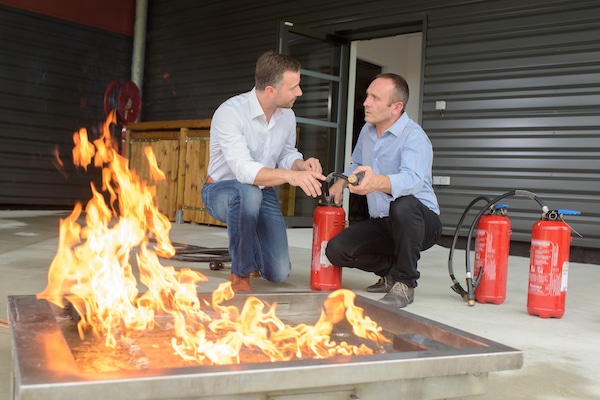
Fire Extinguisher Toolbox Talk – Safety Guidelines
Often a workplace will have certain employees or designated safety officers whose role it is to use extinguishers when appropriate. If fire extinguishers are kept on the premises, then there must be at least one employee who has been properly trained in using them.
Toolbox talks aim to provide employees with proper guidelines for using fire extinguishers. However, if you don’t feel confident trying to extinguish a blaze, it’s best to simply get out of the place, leaving belongings behind unless they can be grabbed without delay.
How to Use a Fire Extinguisher Correctly
The PASS method is typically used for extinguishers. The PASS acronym stands for:
- Pull the pin. The pin is the locking mechanism – it prevents accidental discharge. Pull it from the nozzle side before use.
- Aim. Stand an effective distance from the fire and aim the extinguisher at the base of the fire. This is where the incendiary materials are – you extinguish a fire by tackling the source.
- Squeeze. Apply pressure to the lever slowly but firmly. Release the extinguishing agent towards the base of the fire; adjust your aim if it misses or falls short.
- Sweep. Methodically sweep the burning work area with the extinguishing agent. You can fight small fires effectively by treating all burning materials and smothering the blaze. Stop once you’re sure that all flammable components (wood, grease pans, etc.) have been covered and nothing is burning.
Remember that when using fire extinguishers to tackle a blaze, you should still alert the proper authorities at the same time. Fires can quickly spread out of control, and an extinguisher can only do so much. It’s better the emergency services arrive and find that the problem has been dealt with than you assume the extinguisher will fully put out the blaze and then discover you were wrong.
Where Extinguishers Are Located
A talk should focus on the locations of each extinguisher. This is especially important if your workplace has multiple types of extinguishers, as you can do more harm than good if you pull the wrong extinguisher off the wall to treat a fire.
For example, if you have a dry chemical extinguisher, ensure that employees know that this is the only model to use if an electrical fire breaks out and ignites a nearby cardboard pile – and make sure everyone knows where it is.
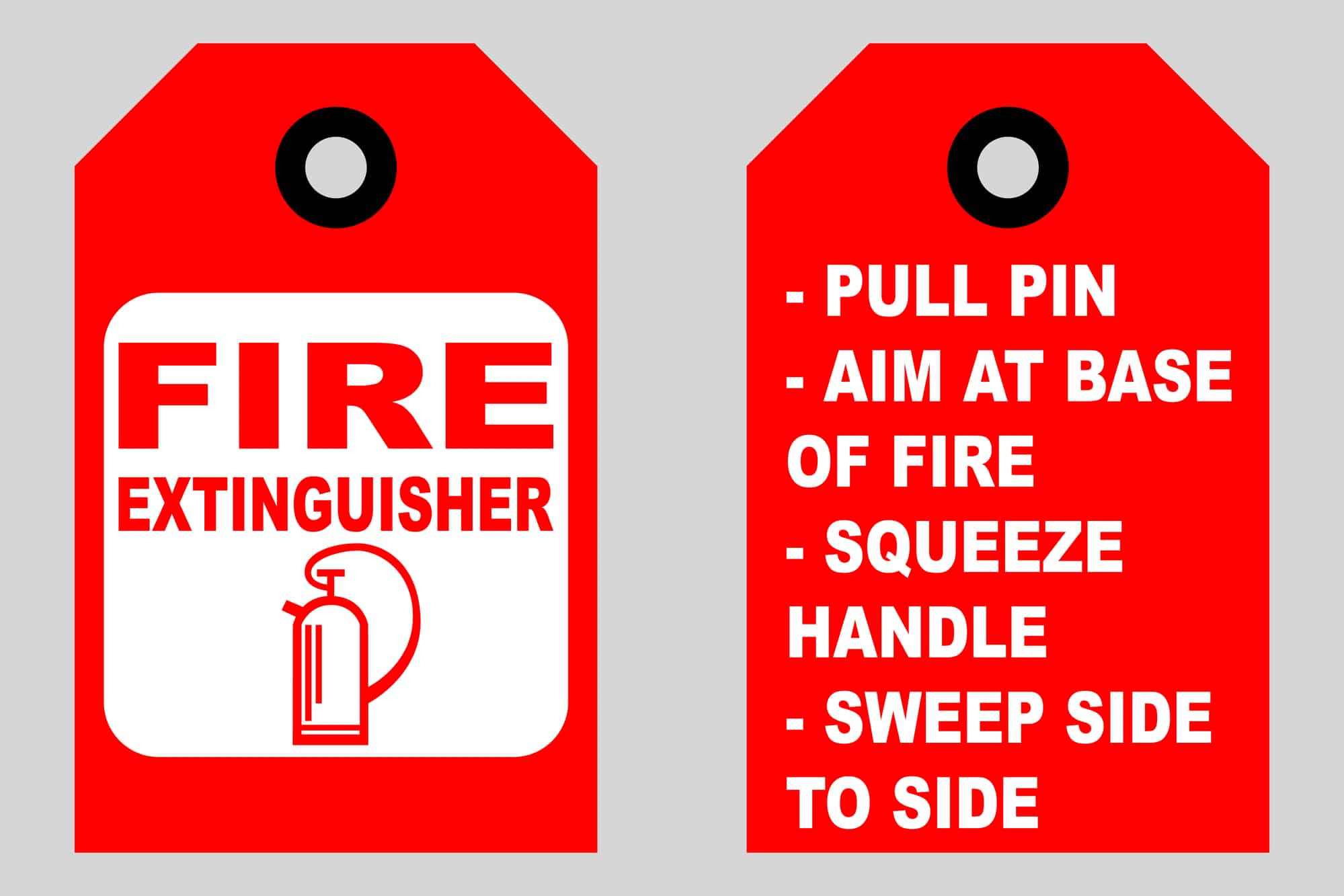
Ask Follow-Up Questions
Following the talk, you should perform an informal or formal check to ensure that employees are comfortable with their knowledge. Here are some suggestions for questions you can ask employees.
What are the 4 types of fire extinguishers?
“What is the easiest way to remember a fire extinguisher?” Each type is color-coded and labeled – employees should know where to look and how to interpret the lettering.
- Type A models have a red label.
- Type K models have a beige label.
- Type BC models have a black label.
- Type ABC models have a blue label.
There are also occasionally “wet chemical” models that have a yellow label. These are rare and won’t be found in most workplaces; they’re similar to type K models but can’t be used on gasoline, solvents, and flammable fluids.
Testing your staff on this is a beneficial safety protocol. It lets you know that in an emergency, employees will be able to respond effectively to a fire. Just as importantly, it means that employees know when not to use an extinguisher on a blaze. Improper use of fire extinguishers can harm individuals and property more than simply vacating the building and shutting fire doors behind you.
What should you do when you hear the fire alarm?
Employees should know that their priorities should be either:
- Getting out of the building & calling the firefighters
- If properly trained, identify where the blaze is and assess whether they can treat it effectively.
- An employee trained to use an extinguisher should quickly judge whether they can tackle the blaze with a nearby unit. They should know whether nearby extinguishers are appropriate for the type of blaze and consider whether it would be safer to leave it – if firefighting doesn’t work, might the blaze spread to block potential escape routes?
- If there’s a question about safety, the best option is to leave the building.
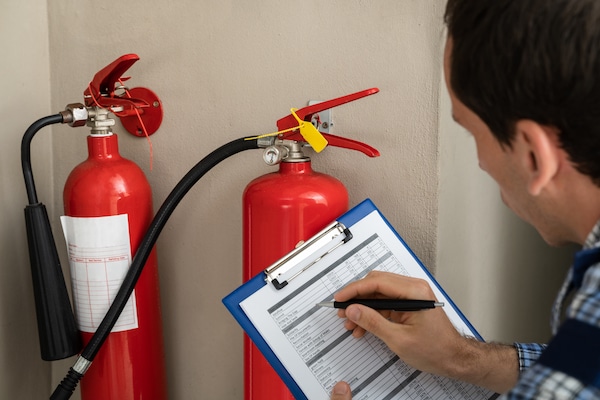
What are the 7 parts of a fire extinguisher?
This question is designed to make employees think about what they’re looking for when they consider an extinguisher. Components might include:
- The nozzle
- The pin
- The body
- The code (A, ABC, etc.)
- The lever
- The descriptive label
- The hose
Everyone knows what one looks like, but does everyone know how to use one? Thinking about which component is which will help staff remain calm and use the equipment properly in an emergency.
Final Thoughts
A fire extinguisher toolbox talk is a great way to augment the knowledge your staff gains through more formal means of training. Scheduling routine talks to ensure that your team is well-informed about what to do when a blaze breaks out is the best way to keep your workplace safe and secure.